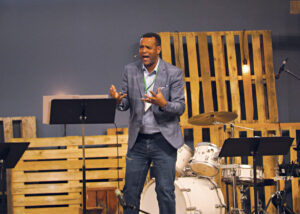Who is a Canadian Mennonite?
I stood in line for supper at the start of a church convention this summer, and looked at my turquoise toenails, a splurge in the airport during a two-hour delay, and wondered if that had been a big mistake. I was at the Evangelical Mennonite Church (EMC) convention taking place this year in Picture Butte, Alta. All the women near me were wearing closed-toe shoes with skirts and dresses, many of them pushing strollers—more strollers than I have ever seen at a church convention.
I was reminded that we have significant cultural and theological diversity right here in Canada. Because I am on staff at Mennonite World Conference (MWC), I have access to statistics, even though they are not always as accurate as we would like. Based on 2018 MWC stats, there were 149,367 adult-baptized Anabaptists in Canada, of which just five of the 22 different groups are members of MWC. I am aware that the people who visit across these different Anabaptist groups are very few and also very privileged.
Can you guess which are the biggest Anabaptist groups in Canada? The top five groups, (75 percent of total adult members), in order of reported size: Canadian Conference of Mennonite Brethren Churches, Mennonite Church Canada, Be in Christ Church of Canada, Hutterian Brethren Church and Old Colony Mennonite Church. The remaining 17 groups (25 percent of total baptized adults) can be classified as either Russian heritage traditionalist groups or as German/Swiss heritage traditionalist groups.
Some of the 22 groups worship in more than 20 different languages every Sunday, of which Mennonite Church Canada seems to have the most linguistic diversity. And yet more than half of adult Anabaptists in Canada belong to groups that remain ethnically monocultural, albeit not the same as each other.
All 22 of these groups agree to the same seven Shared Convictions from MWC. But we differ dramatically on many theological issues beyond these Shared Convictions. Sometimes those differences manage to co-exist within one of these groups, and sometimes those differences mean more divisions and separations. Are all those differences purely theological, or are some derived from our respective cultures? I am often sceptical about whether theology drives our cultural traditions, or our cultural traditions shape our theology.
And so I stood in line, in a dress with my flashing turquoise toenails, and I felt very self-conscious. But then the line moved. We were each given a plate of chicken and rice with very spicy hot sauce, cooked by the Hispanic EMC congregations. As we gathered at round tables, I saw that there were many women who dressed like me, and there were many who were more conservatively dressed. But everyone belonged.
During the services, simultaneous translation was provided into Low German and Spanish. We sang about, and listened to, sermons on unity in the church. And in the end it did not matter that my toenails had become turquoise earlier that same day. We worshipped together and welcomed each other.
When your neighbour wants to know “who is a Mennonite?” how do you respond? Do we each talk only about our own group, or do we acknowledge the existence of the others in this larger Anabaptist body, even in our own country?
I pray that our diverse cultural and theological heritages will strengthen us as sisters and brothers, in following Jesus and in growing in the depth and breadth of our experience of the love of God.
Arli Klassen is a member of First Mennonite Church, Kitchener, Ont.; the moderator of Mennonite Church Eastern Canada; a member of the MC Canada Joint Council; and on staff at Mennonite World Conference. In this column, Arli speaks for none but herself, and even that perspective might shift depending on the day and context.









Leave a Reply
You must be logged in to post a comment.